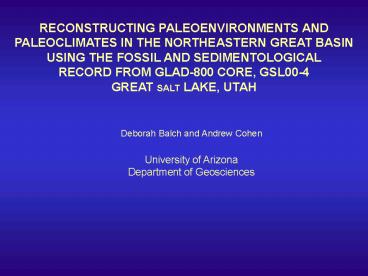RECONSTRUCTING PALEOENVIRONMENTS AND PowerPoint PPT Presentation
1 / 22
Title: RECONSTRUCTING PALEOENVIRONMENTS AND
1
RECONSTRUCTING PALEOENVIRONMENTS AND
PALEOCLIMATES IN THE NORTHEASTERN GREAT
BASIN USING THE FOSSIL AND SEDIMENTOLOGICAL RECORD
FROM GLAD-800 CORE, GSL00-4 GREAT SALT LAKE, UTAH
Deborah Balch and Andrew Cohen University of
Arizona Department of Geosciences
2
Late 1990s International Continental Drilling
Program (ICDP) provided the funds for DOSECC to
develop the GLAD800 Lake Drilling System With
NSF support, the GLAD800 was first tested at the
Great Salt Lake and Bear Lake in August 2000
3
CORING AT SITE 4
(Dean et al, 2002)
- Located on Southeast
- margin of the northern
- basin in the hanging
- wall of the Carrington
- Fault
- Longest core (121mblf)
- OBJECTIVE
- Obtain a detailed basinal
- history extending to
- OIS 6, use it to address
- questions related to
- paleoclimate
4
OVERVIEW OF PREVIOUS RESEARCH
- Four deep lake cycles in the past 500,000 yr BP
- lake level fluctuations due to migration of jet
stream - during glacial advance (Thompson et al. 1993
Kutzbach et al. 1993 COHMAP) - Lake Bonneville OIS 2
- (i.e.Spencer et al. 1984 Currey and Oviatt,
1985Oviatt et al. 1992,Oviatt, 1997 - Sack, 1999 Oviatt et al. 2001)
- Cutler Dam OIS 4
- (Oviatt et al., 1987 Kaufman et al. 2001)
- Little Valley OIS 6
- (Scott et al. 1983Oviatt et al.1999)
- Pokes Point OIS 12
- (Oviatt et al., 1999)
5
OVERVIEW OF PREVIOUS RESEARCH
- AMOCO Wells, 1970s
- (Davis, 1998 Davis and Moutoux, 1998 Kowalewska
and Cohen, 1998) - GSL has long history - Miocene
- Evidence that GSL sediments contain one of the
- continuous Neogene records of North American
- climate and environmental change
6
OVERVIEW OF PREVIOUS RESEARCH
GLAD800 Drilling
Preliminary Study of GSL00-4 (Dean et al. 2002)
- Core catcher samples (3 meter intervals 6000
yr resolution) - Paleoecological record going back 250,000 yr BP
- Analyzed for ostracodes, other invertebrates and
pollen - Lake fluctuates between marsh and saline
conditions - Too low resolution to explain these cycles in
detail
7
OUR OBJECTIVE
- Improve sampling, better resolution
- Resolve chronological sequence of
paleoenvironmental - and paleolimnological change
- Determine if fluctuations in previous lake
conditions - correlate with glacial/interglacial sequences
8
Work by Debbie Balch 2002 Internship Award
- Assemble higher resolution paleoenvironmental
- record from GSL00-4 (Great Salt Lake Core)
- Sample every meter (2000 yr resolution)
- Primary indicators
- A. Fossils
- Ostracodes
- Brine shrimp
- Brine flies
- Molluscs
- B. Sediments
- Lithostratigraphy
- Mineralogy
9
METHODS
- A. Sampling the core
- 124 total samples (1 meter interval)
- micropaleontologic and sedimentary indicators
visually estimated as /sample - ostracodes,brine flies and brine shrimp fossils
were subsampled and counted to estimate /gm - Brine Flies sampled every 3 meters
- Depth profiles created for each indicator
10
METHODS
B. Multivariate Analysis of Ostracode Assemblages
- DCA (Detrended Correspondence Analysis)
- Restrictions to increase robustness
- (A) sample must contain gt 10 valves/gm
- (B) species must have abundance of
- gt 10 valves/gm in at least one sample
- arcsine transformed, used data
11
MULTIVARIATE ANALYSIS
- DCA Axis 1 accounts for 28.4 of the total
variance - may be salinity gradient?
- DCA Axis 2 accounts for 17.4 of the total
variance - may be water depth? or vegetation gradient?
12
MULTIVARIATE ANALYSIS
shallow? vegetated?
deeper? less vegetation?
Three Distinct Groups marsh (i.e.
Cyprideis spp. Hetercypris spp.) fresh open
water (i.e. Candona spp.) saline open water
(i.e. Limnocythere staplini)
13
METHODS
C. Age Model
- Carbon-14 (charcoal and leaf hairs)
- U-series dates (Edwards and Cheng)
- Biostratigraphic Correlation (Thompson et
al.,1990) - Tephras (Mazama and Hansel Valley)
1mm
14
RESULTS AGE MODEL
CORRECTED U-SERIES
UNCORRECTED U-SERIES
UPPER 19 meters y12.463x3-307.995x23095.534x (R2
0.994, plt0.0001)
UPPER 19 meters y21.105x3-491.698x23887.704x (R2
0.993, plt0.0001)
BELOW 19 meters y2006.827x (R20.959, plt0.0001)
BELOW 19 meters y2528.843x (R20.994, plt0.0001)
15
19 - 121 mblf
AGE
CORRECTED U-series dates
0 - 19 mblf
same data point (19mblf, 30838 5000 yr BP)
Tephra
Biostratigraphic Correlation
U-series (dates excluded from model )
Carbon-14
16
RESULTS
Paleoecology
- Horizontal color bars correspond with ostracode
DCA
open saline water
marsh
open fresh water
17
RESULTS
LITHOSTRATIGRAPY
PALEOECOLOGY
No Data
- Paleoecology
- correlates with
- lithostratigraphy
LEGEND
Gray carbonate clay/silt/mud
Evaporite muddy evaporites
Laminated carbonate muds diatomaceous muds
Carbonate muds mottled, pseudomicrokarst
structures, roots, dewatering structures
Clay w/gypsum
No Data
Massive-banded sands/silts muds (some mottling
bioturbation)
Dean et al. 2002
18
CORE
LAKE LEVEL
Open Fresh Water
High
- Candona spp.
- laminated seds
- L. staplini
- laminated seds
- evaporites
Open Saline Water
Lower
- marsh ostracodes
- molluscs
- mottled carbonates
- roots
Marsh
Below core site
19
GLS00-4 AND CLIMATE CHANGE
SPECMAP
PALEOECOLOGY
OIS
HIGHSTAND
1
B
2
3
CD
4
5
LV?
6
7
(Martinson et al. 1987)
20
CONCLUSIONS
- Paleoecological indicators show fluctuations
between - marsh/fresh open water/saline open water
- -sedimentology supports this
- Established age model
- -some inconsistencies
- Cycles correspond with paleohydrological model
of - lake level
- -consistent with terrace shore studies
- Everything fits into global model of climate
change
21
Exciting Times ahead for GSL00-4! ...this is
only the beginning
- High resolution records for three
- glacial/interglacial sequences!
22
ACKNOWLEGMENTS
- DOSECC and NSF
- Doug Schnurrenberger
- Rick Forester
- Manuel Palacios-Fest
- Jack Oviatt
- Warren Beck
- Larry Edwards
- Hai Cheng
- Karen Bossenbroek
- Owen Davis
- Kaustuv Roy

